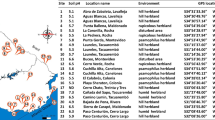Abstract
The genetic diversity and phylogeny of root nodule bacteria, microsymbionts of plants of the genus Lupinaster Adans. (L. albus Link and L. pentaphyllus Moench), were studied, and also their symbiotic genes were analyzed. The bacterial strains studied were shown to be phylogenetically different; however, all of them are related to the Mezorhizobium genus with the exception of the single strain which is related to the Rhizobium genus. Analysis of the symbiotic genes nifH and nodC revealed their high homology among all strains independently of strain phylogeny, as well as the phylogenetic relation of these genes to those of Mezorhizobium. Mezorhizobium bacteria are likely specific microsymbionts of these plants, while the Rhizobium strain acquired its symbiotic genes and became capable of nodule formation in Lupinaster plants through horizontal gene transfer. Thus, the genetic composition of nodule bacteria inhabiting Lupinaster plants represents additional support for the idea that they do not belong to the Trifolium genus.




Similar content being viewed by others
REFERENCES
Bobrov, E.G., Clover—Trifolium L., in Flora SSSR (Flora of the Soviet Union), Moscow: Akad. Nauk SSSR, 1945, vol. 11, pp. 189—261.
Bobrov, E.G., Lupinaster Adans, in Flora evropeiskoi chasti SSSR (Flora of the European Part of the USSR), Leningrad: Nauka, 1987, vol. 6, pp. 208—209.
Roskov, Yu.R., On the directions of evolution and the main taxonomic units in the Trifolium s. l. (Fabaceae) group, Bot. Zh., 1989, vol. 74, pp. 36—43.
Yakovlev, G.P., Bobovye zemnogo shara (Legumes of the Globe), Leningrad: Nauka, 1991.
Polozhii, A.V., Vydrina, S.N., and Kurbatskii, V.I., Flora Sibiri: Fabaceae (Leguminosae) (Flora of Siberia: Fabaceae (Leguminosae)), Novosibirsk: Nauka, 1994.
Bobrov, E.G., On the span of the genus Trifolium s. l., Bot. Zh., 1967, vol. 52, no. 11, pp. 1593—1599.
Mutch, L.A. and Young, J.P., Diversity and specificity of Rhizobium leguminosarum biovar viciae on wild and cultivated legumes, Mol. Ecol., 2004, vol. 13, pp. 2435—2444. https://doi.org/10.1111/j.1365-294X.2004.02259.x
Roumiantseva, M.L., Andronov, E.E., Sharypova, L.A., et al., Diversity of Sinorhizobium meliloti from the Central Asian alfalfa gene center, Appl. Environ. Microbiol., 2002, vol. 68, pp. 4694—4697. https://doi.org/10.1128/AEM.68.9.4694-4697.2002
Eardly, B., Elia, P., Brockwell, J., et al., Biogeography of a novel Ensifer meliloti clade associated with the Australian legume Trigonella suavissima, Appl. Environ. Microbiol., 2017, vol. 83. e03446-16. https://doi.org/10.1128/AEM.03446-16
Andrews, M. and Andrews, M.E., Specificity in legume—rhizobia symbioses, Int. J. Mol. Sci., 2017, vol. 18, p. 705. https://doi.org/10.3390/ijms18040705
Bailly, X., Olivieri, I., Brunel, B., et al., Horizontal gene transfer and homologous recombination drive the evolution of the nitrogen-fixing symbionts of Medicago species, J. Bacteriol., 2007, vol. 189, pp. 5223—5236. https://doi.org/10.1128/JB.00105-07
Sprent, J., Nodulation in legumes, Ann. Bot., 2002, vol. 89, no. 6, pp. 797—798. https://doi.org/10.1093/aob/mcf128
Wdowiak-Wrobel, S., Marek-Kozaczuk, M., Kalita, M., et al., Diversity and plant growth promoting properties of rhizobia isolated from root nodules of Ononis arvensis, Antonie van Leeuwenhoek, 2017, vol. 110, pp. 1087—1103. https://doi.org/10.1007/s10482-017-0883-x
Baimiev, An.Kh., Ptitsyn, K.G., and Baimiev, Al.Kh., Influence of the introduction of Caragana arborescens on the composition of its root-nodule bacteria, Microbiology (Moscow), 2010, vol. 79, no. 1, pp. 115—120. https://doi.org/10.1134/S0026261710010157
Williams, J.G., Kubelik, A.R., Livak, K.J., et al., DNA polymorphisms amplified by arbitrary primers are useful as genetic markers, Nucleic Acids Res., 1990, vol. 18, no. 22, pp. 6531—6535.
Laguerre, G.P., Mavingui, M.R., Allard, M.P., et al., Typing of rhizobia by PCR DNA fingerprinting and PCR-restriction fragment length polymorphism analysis of chromosomal and symbiotic gene regions: application to Rhizobium leguminosarum and its different biovars, Appl. Environ. Microbiol., 1996, vol. 62, pp. 2029—2036.
Weisburg, W.G., Barns, S.M., Pelletier, D.A., and Lane, D.J., 16S ribosomal DNA amplification for phylogenetic study, J. Bacteriol., 1991, vol. 173, pp. 697—703.
Baimiev, An.Kh., Ivanova, E.S., Gumenko, R.S., et al., Analysis of symbiotic genes of leguminous root nodule bacteria grown in the Southern Urals, Russ. J. Genet., 2015, vol. 51, no. 12, pp. 1172—1180. https://doi.org/10.1134/S1022795415110034.
Provorov, N.A., Vorob’ev, N.I., and Tikhonovich, I.A., Geneticheskie osnovy evolyutsii rastitel’no-mikrobnogo simbioza (Evolutionary Genetics of Plant—Microbe Symbioses), St. Petersburg: Inform-Navigator, 2012.
Fred, E.B., Baldwin, I.L., and McCoy, E., Root Nodule Bacteria and Leguminous Plants, Madisson: Univ. Wisconsin Stud. Sci., 1932.
Tikhonovich, I.A. and Provorov, N.A., Simbiozy rastenii i mikroorganizmov: molekulyarnaya genetika agrosistem budushchego (Symbioses of Plants and Microorganisms: Molecular Genetics of Future Agricultural Systems), St. Petersburg: St. Petersburg Gos. Univ., 2009.
Baimiev, An.Kh., Ivanova, E.S., Ptitsyn, K.G., Belimov, A.A., Safronova, V.I., and Baimiev, Al.Kh., Genetic characterization of wild legume nodule bacteria of the Southern Urals, Mol. Genet. Microbiol. Virol., 2012, vol. 27, no. 1, pp. 33—39. https://doi.org/10.3103/S0891416812010028
Provorov, N.A. and Vorobyov, N.I., Evolution of symbiotic bacteria in “plant—soil” systems: interplay of molecular and population mechanisms, Progress in Environmental Microbiology, Kim, M.-B., Ed., New York: Nova Sci. Publ., 2008, pp. 11—67.
Author information
Authors and Affiliations
Corresponding author
Additional information
Translated by A. Boutanaev
Rights and permissions
About this article
Cite this article
Baymiev, A.K., Akimova, E.S., Gumenko, R.S. et al. Genetic Diversity and Phylogeny of Root Nodule Bacteria Isolated from Nodules of Plants of the Lupinaster Genus Inhabiting the Southern Urals. Russ J Genet 55, 45–51 (2019). https://doi.org/10.1134/S1022795419010022
Received:
Revised:
Accepted:
Published:
Issue Date:
DOI: https://doi.org/10.1134/S1022795419010022




